coolant temperature TOYOTA YARIS 2014 3.G Owners Manual
[x] Cancel search | Manufacturer: TOYOTA, Model Year: 2014, Model line: YARIS, Model: TOYOTA YARIS 2014 3.GPages: 400, PDF Size: 9 MB
Page 135 of 400

135
2-2. Instrument cluster
2
When driving
Instrument panel light control
The brightness of the instrument pa nel lights can be adjusted by turn-
ing the dial.
Brighter
Darker
■The meters and display operate when
The engine switch is in the “ON” position.
NOTICE
■To prevent damage to the engine and its components
●On vehicles with a tachometer, do not let the indicator needle of the
tachometer enter the red zone, which indicates the maximum engine
speed.
● The engine may be overheating if the high engine coolant temperature
warning light flashes or comes on. In this case, immediately stop the vehi-
cle in a safe place, and check the engine after it has cooled completely.
( P. 334)
Page 138 of 400
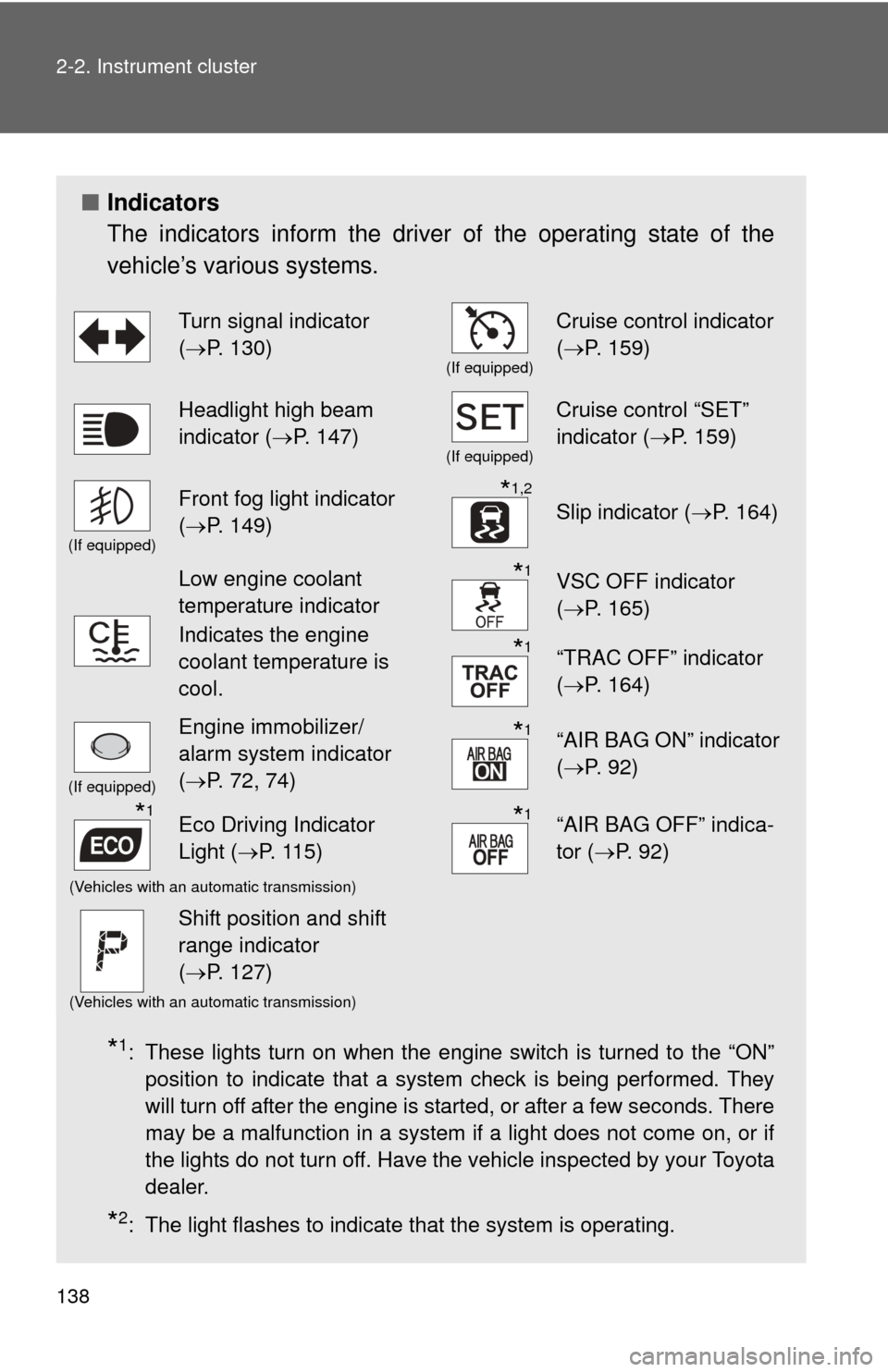
138 2-2. Instrument cluster
■Indicators
The indicators inform the driver of the operating state of the
vehicle’s various systems.
*1: These lights turn on when the engine switch is turned to the “ON”
position to indicate that a system check is being performed. They
will turn off after the engine is started, or after a few seconds. There
may be a malfunction in a system if a light does not come on, or if
the lights do not turn off. Have the vehicle inspected by your Toyota
dealer.
*2: The light flashes to indicate that the system is operating.
Turn signal indicator
(P. 130)
(If equipped)
Cruise control indicator
( P. 159)
Headlight high beam
indicator ( P. 147)
(If equipped)
Cruise control “SET”
indicator ( P. 159)
(If equipped)
Front fog light indicator
(P. 149)*1,2
Slip indicator ( P. 164)
Low engine coolant
temperature indicator
Indicates the engine
coolant temperature is
cool.*1VSC OFF indicator
(P. 165)
*1“TRAC OFF” indicator
(P. 164)
(If equipped)
Engine immobilizer/
alarm system indicator
(P. 72, 74)*1“AIR BAG ON” indicator
( P. 92)
*1Eco Driving Indicator
Light ( P. 115)*1“AIR BAG OFF” indica-
tor (P. 92)
(Vehicles with an automatic transmission)
Shift position and shift
range indicator
(P. 127)
(Vehicles with an automatic transmission)
Page 237 of 400
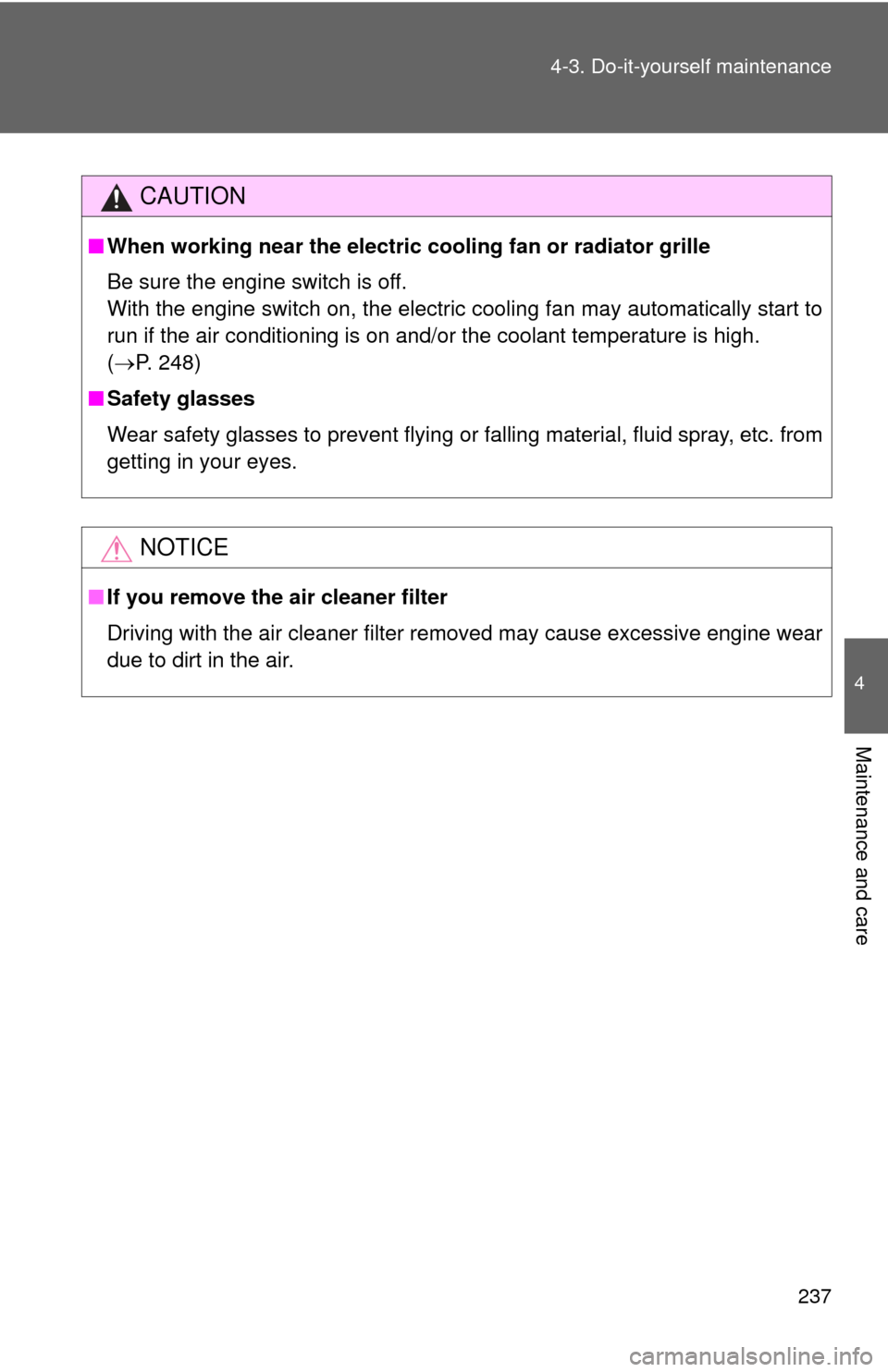
237
4-3. Do-it-yourself maintenance
4
Maintenance and care
CAUTION
■
When working near the electric cooling fan or radiator grille
Be sure the engine switch is off.
With the engine switch on, the electric cooling fan may automatically start to
run if the air conditioning is on and/or the coolant temperature is high.
( P. 248)
■ Safety glasses
Wear safety glasses to prevent flying or falling material, fluid spray, etc. from
getting in your eyes.
NOTICE
■If you remove the air cleaner filter
Driving with the air cleaner filter removed may cause excessive engine wear
due to dirt in the air.
Page 247 of 400
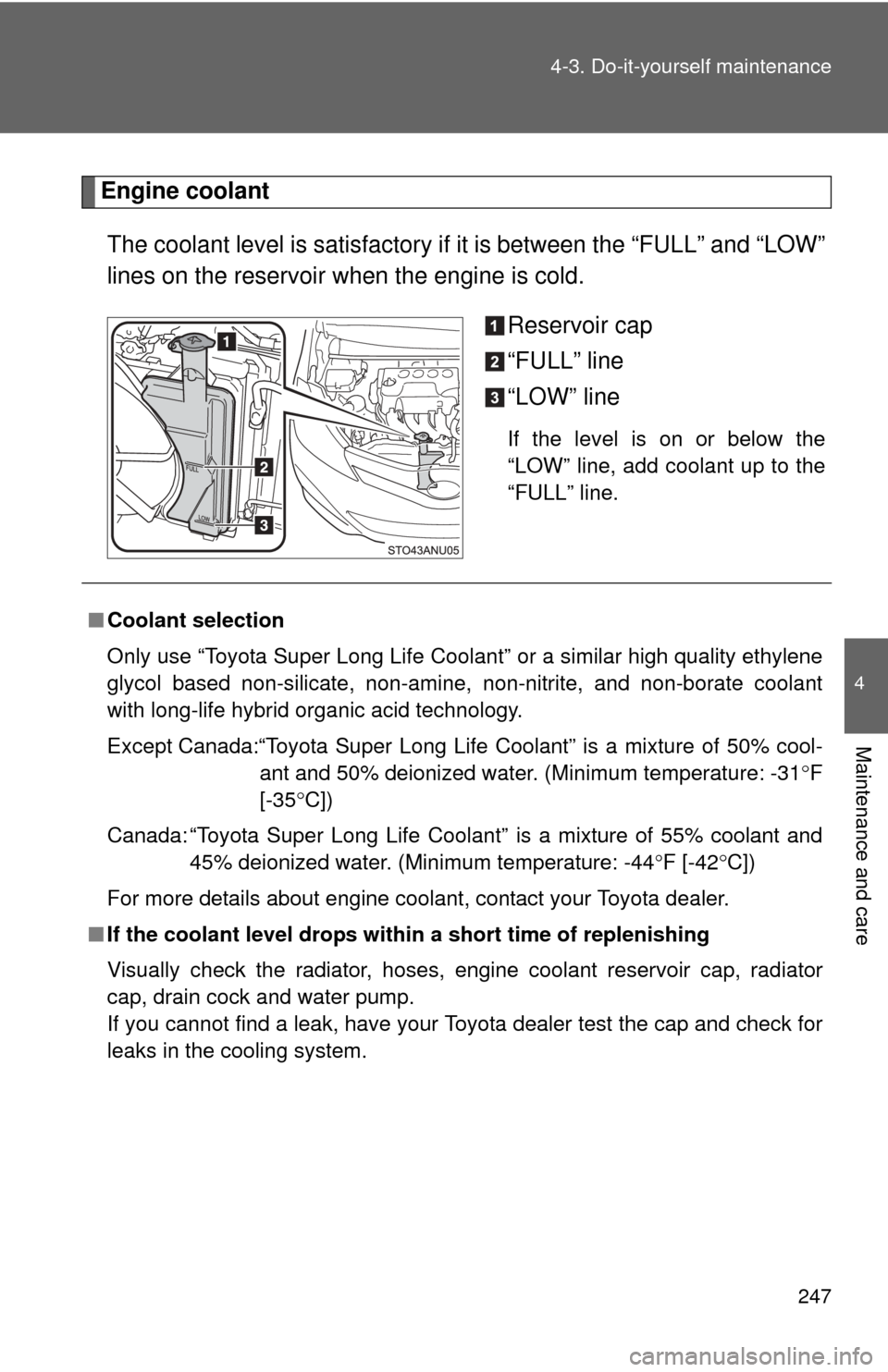
247
4-3. Do-it-yourself maintenance
4
Maintenance and care
Engine coolant
The coolant level is satisfactory if it is between the “FULL” and “LOW”
lines on the reservoir when the engine is cold.
Reservoir cap
“FULL” line
“LOW” line
If the level is on or below the
“LOW” line, add coolant up to the
“FULL” line.
■Coolant selection
Only use “Toyota Super Long Life Coolant” or a similar high quality ethylene
glycol based non-silicate, non-amine, non-nitrite, and non-borate coolant
with long-life hybrid organic acid technology.
Except Canada:“Toyota Super Long Life Coolant” is a mixture of 50% cool- ant and 50% deionized water. (Minimum temperature: -31 F
[-35 C])
Canada: “Toyota Super Long Life Coolant” is a mixture of 55% coolant and 45% deionized water. (Minimum temperature: -44 F [-42 C])
For more details about engine coolant, contact your Toyota dealer.
■ If the coolant level drops within a short time of replenishing
Visually check the radiator, hoses, engine coolant reservoir cap, radiator
cap, drain cock and water pump.
If you cannot find a leak, have your Toyota dealer test the cap and check for
leaks in the cooling system.
Page 303 of 400
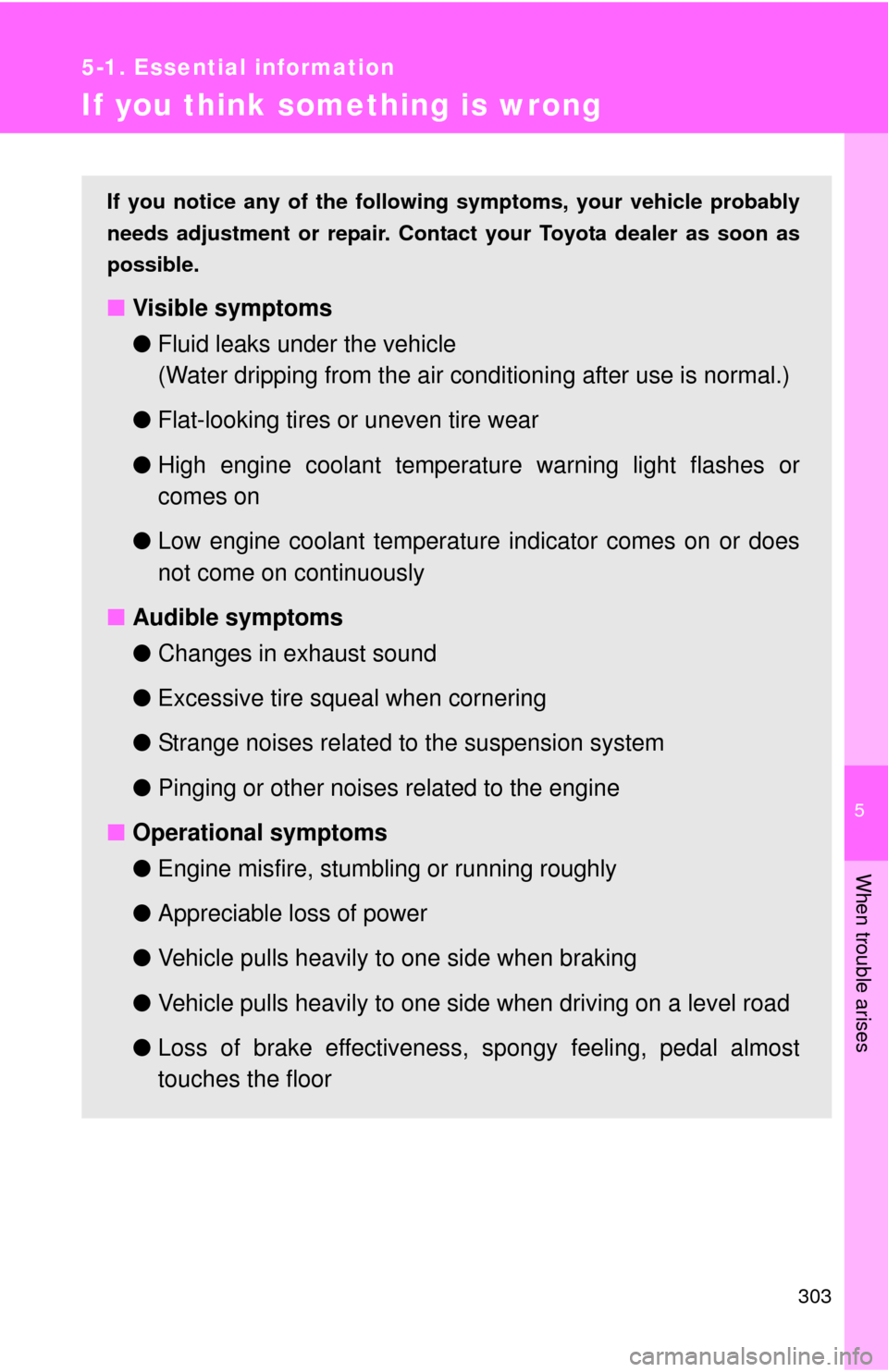
5
When trouble arises
303
5-1. Essential information
If you think something is wrong
If you notice any of the following symptoms, your vehicle probably
needs adjustment or repair. Contact your Toyota dealer as soon as
possible.
■ Visible symptoms
●Fluid leaks under the vehicle
(Water dripping from the air cond itioning after use is normal.)
● Flat-looking tires or uneven tire wear
● High engine coolant temperatur e warning light flashes or
comes on
● Low engine coolant temperature indicator comes on or does
not come on continuously
■ Audible symptoms
●Changes in exhaust sound
● Excessive tire squeal when cornering
● Strange noises related to the suspension system
● Pinging or other noises related to the engine
■ Operational symptoms
●Engine misfire, stumb ling or running roughly
● Appreciable loss of power
● Vehicle pulls heavily to one side when braking
● Vehicle pulls heavily to one side when driving on a level road
● Loss of brake effectiveness, s pongy feeling, pedal almost
touches the floor
Page 306 of 400
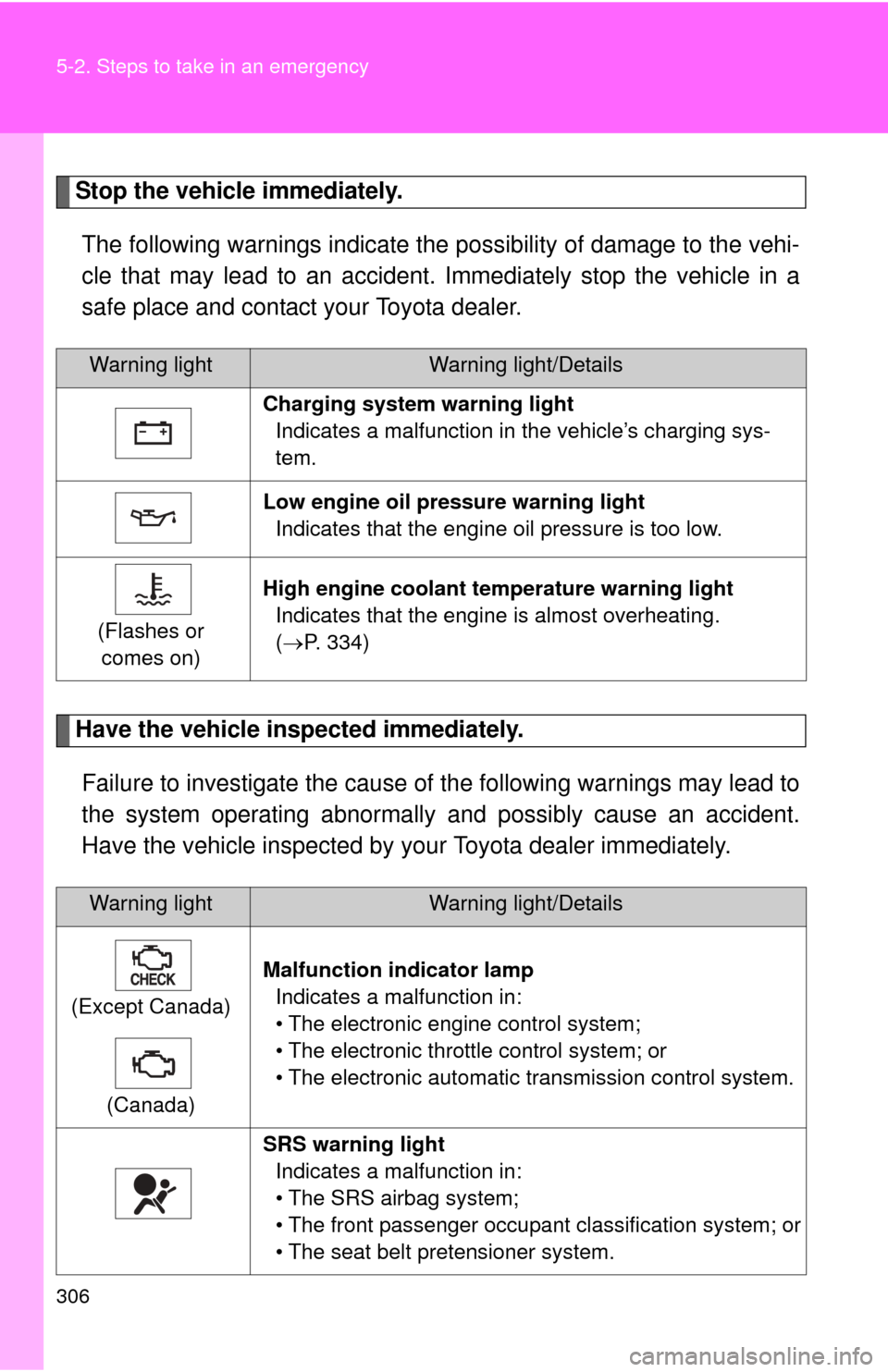
306 5-2. Steps to take in an emergency
Stop the vehicle immediately.The following warnings indicate the possibility of damage to the vehi-
cle that may lead to an accident. Immediately stop the vehicle in a
safe place and contact your Toyota dealer.
Have the vehicle inspected immediately.Failure to investigate the cause of the following warnings may lead to
the system operating abnormally and possibly cause an accident.
Have the vehicle inspected by your Toyota dealer immediately.
Warning lightWarning light/Details
Charging system warning light Indicates a malfunction in the vehicle’s charging sys-
tem.
Low engine oil pressure warning light Indicates that the engine oil pressure is too low.
(Flashes or comes on) High engine coolant temperature warning light
Indicates that the engine is almost overheating.
(P. 334)
Warning lightWarning light/Details
(Except Canada) (Canada) Malfunction indicator lamp
Indicates a malfunction in:
• The electronic engine control system;
• The electronic throttle control system; or
• The electronic automatic transmission control system.
SRS warning light Indicates a malfunction in:
• The SRS airbag system;
• The front passenger occupant classification system; or
• The seat belt pretensioner system.
Page 335 of 400
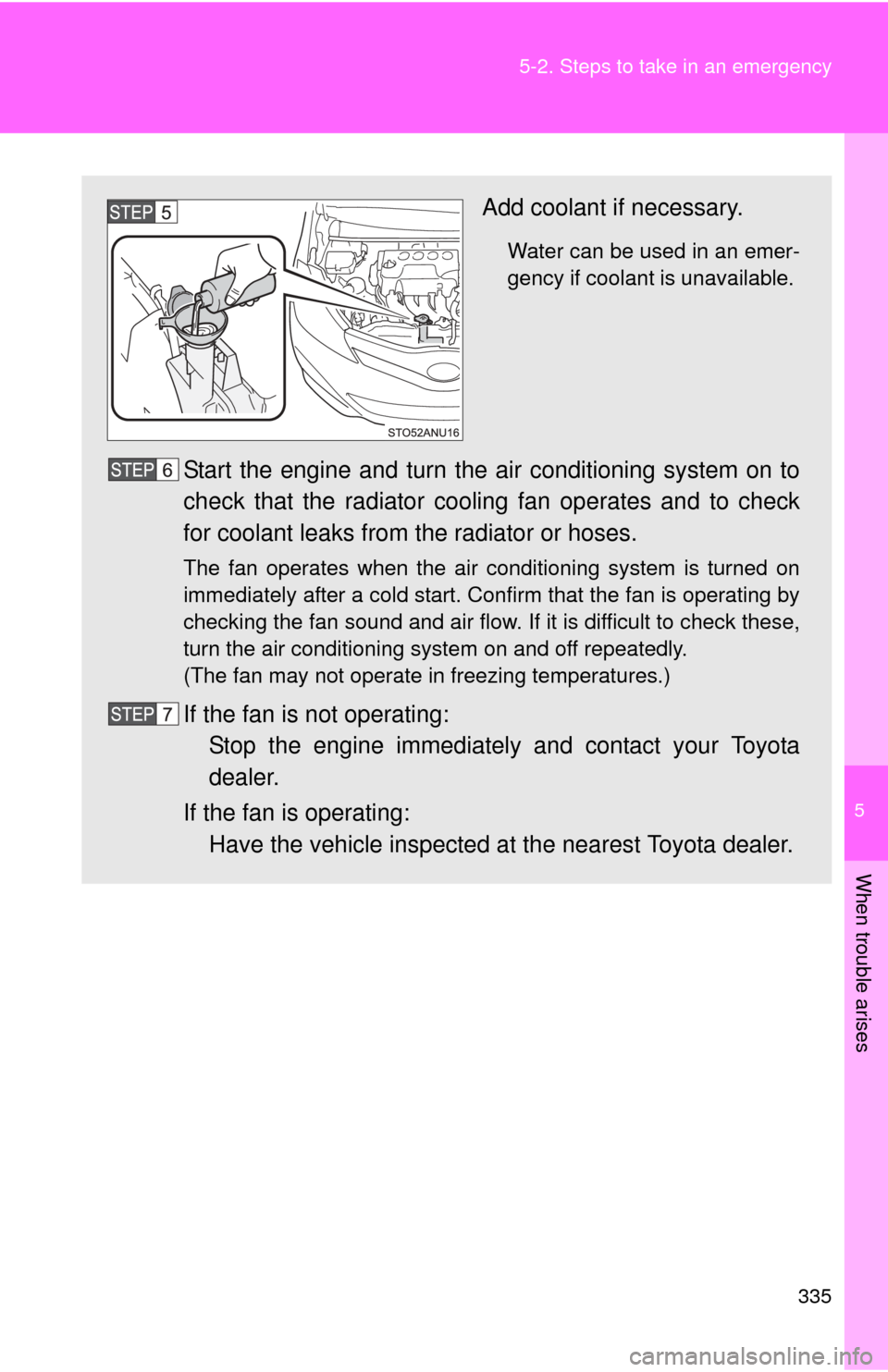
5
When trouble arises
335
5-2. Steps to take in an emergency
Add coolant if necessary.
Water can be used in an emer-
gency if coolant is unavailable.
Start the engine and turn the ai
r conditioning system on to
check that the radiator cooling fan operates and to check
for coolant leaks from the radiator or hoses.
The fan operates when the air conditioning system is turned on
immediately after a cold start. Confirm that the fan is operating by
checking the fan sound and air flow. If it is difficult to check these,
turn the air conditioning system on and off repeatedly.
(The fan may not operate in freezing temperatures.)
If the fan is not operating: Stop the engine immediately and contact your Toyota
dealer.
If the fan is operating: Have the vehicle inspected at the nearest Toyota dealer.
Page 347 of 400

347
6-1. Specifications
6
Vehicle specifications
Oil viscosity (5W-30 is explained here as an example):
●
The 5W in 5W-30 indicates the characteristic of the oil which allows
cold startability. Oils with a lower value before the W allow for easier
starting of the engine in cold weather.
● The 30 in 5W-30 indicates the viscosity characteristic of the oil when
the oil is at high temperature. An oil with a higher viscosity (one with a
higher value) may be better suited if the vehicle is operated at high
speeds, or under extreme load conditions.
How to read oil container label:
The ILSAC (International Lubric ant Standardization and Approval
Committee) Certification Mark is added to some oil containers to help
you select the oil you should use.
Cooling system
Capacity
(Reference) Vehicles with an automatic transmission:
4.9 qt. (4.6 L, 4.0 Imp.qt.)
Vehicles with a manual transmission:
5.0 qt. (4.7 L, 4.1 Imp.qt.)
Coolant typeUse either of the following:
• “Toyota Super Long Life Coolant”
• A similar high-quality ethylene glycol-based non-silicate, non-amine, non-nitrite,
and non-borate coolant with long-life
hybrid organic acid technology
Do not use plain water alone.
Page 362 of 400
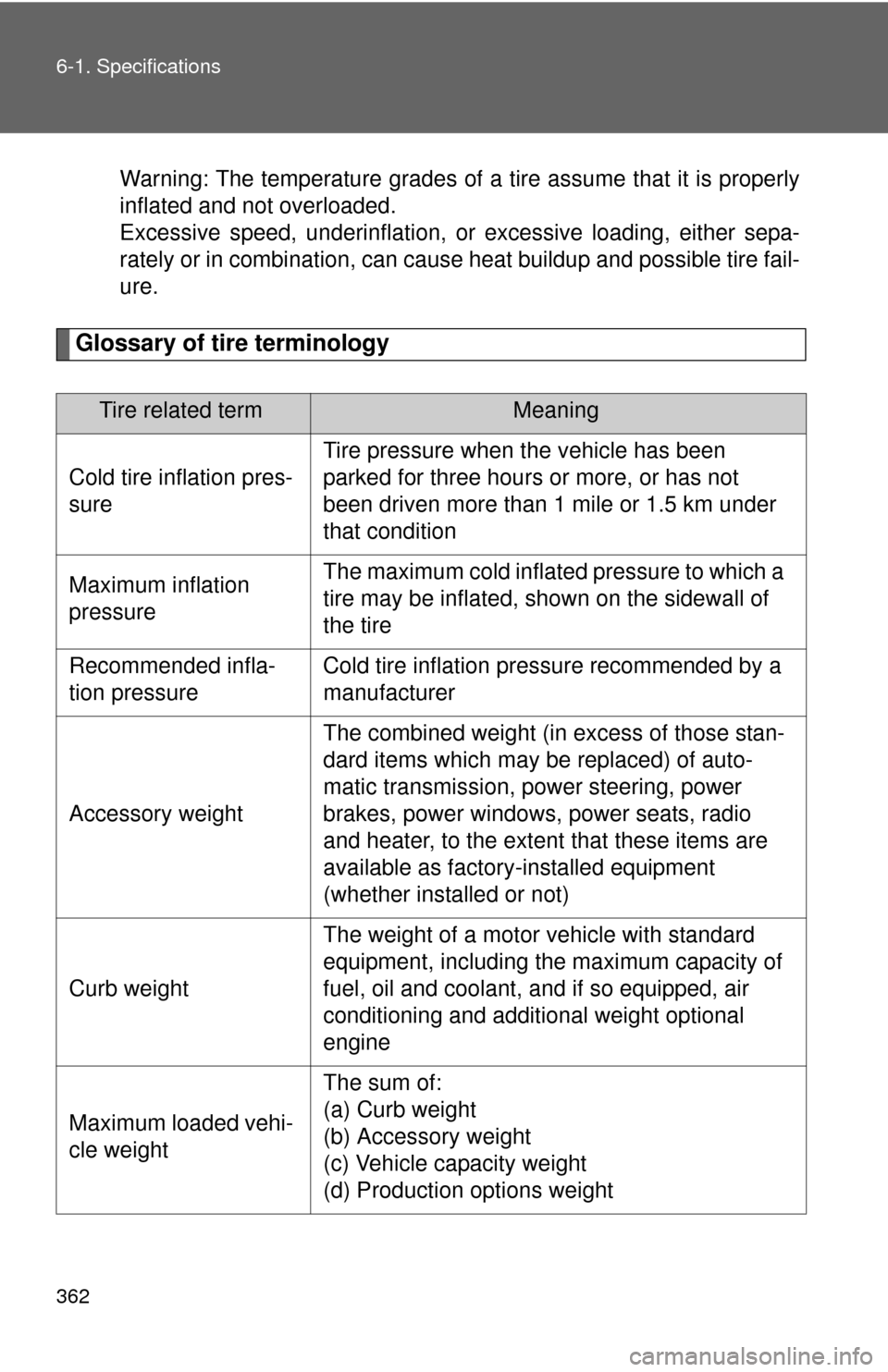
362 6-1. Specifications
Warning: The temperature grades of a tire assume that it is properly
inflated and not overloaded.
Excessive speed, underinflation, or excessive loading, either sepa-
rately or in combination, can cause heat buildup and possible tire fail-
ure.
Glossary of tire terminology
Tire related termMeaning
Cold tire inflation pres-
sure
Tire pressure when the vehicle has been
parked for three hours or more, or has not
been driven more than 1 mile or 1.5 km under
that condition
Maximum inflation
pressureThe maximum cold inflated pressure to which a
tire may be inflated, s hown on the sidewall of
the tire
Recommended infla-
tion pressureCold tire inflation pressure recommended by a
manufacturer
Accessory weight
The combined weight (in excess of those stan-
dard items which may be replaced) of auto-
matic transmission, power steering, power
brakes, power windows, power seats, radio
and heater, to the extent that these items are
available as factory-installed equipment
(whether installed or not)
Curb weight
The weight of a motor vehicle with standard
equipment, including the maximum capacity of
fuel, oil and coolant, and if so equipped, air
conditioning and additional weight optional
engine
Maximum loaded vehi-
cle weight
The sum of:
(a) Curb weight
(b) Accessory weight
(c) Vehicle capacity weight
(d) Production options weight
Page 394 of 400

394 Alphabetical index
TiresChains ................................... 173
Checking ............................... 254
Identification number ............. 358
If you have a flat tire .............. 315
Inflation pressure........... 262, 351
Inflation pressure sensor ....... 255
Information ............................ 356
Replacing ...................... 254, 315
Rotating tires ......................... 254
Size ....................................... 351
Snow tires ............................. 173
Spare tire............................... 315
Tire pressure warning
system ........................ 255, 307
Warning light ......................... 307
Tools ......................................... 315
Total load capacity................... 172
Towing Dinghy towing................ 188, 189
Emergency towing................. 297
Trailer towing................. 177, 178
Trip meter ................................. 141
Turn signal lights
Indicator ................................ 136
Lever ..................................... 130
Replacing light bulbs ............. 287
Switch.................................... 130
Wattage ................................. 352
Vanity mirrors........................... 209
Vehicle data recordings ............21
Vehicle identification number ................................... 343
Vehicle stability control........... 163
VSC............................................ 163 Warning buzzers
Brake system ........................ 305
Seat belt reminder................. 307
Warning lights ABS ....................................... 306
Airbag system ....................... 306
Anti-lock brake system .......... 306
Brake system ........................ 305
Charging system .... ............... 306
Cruise control ........................ 306
Driver’s seat belt ................... 307
Electric power steering system ................................ 306
Electronic engine control
system ................................ 306
Engine oil replacement ......... 307
EPS system .......................... 306
Front passenger occupant classification system ........... 306
Front passenger’s seat
belt ...................................... 307
High engine coolant temperature ........................ 306
Low brake fluid ...................... 305
Low engine oil pressure ........ 306
Low tire inflation pressure ..... 307
Low washer fluid ................... 307
Malfunction............................ 306
Open door ............................. 307
Seat belt ................................ 307
Seat belt pretensioner system ................................ 306
Slip ........................................ 306
SRS....................................... 306
SRS airbag system ............... 306
Tire pressure ......................... 307
Tire pressure warning system ................................ 307
V
W